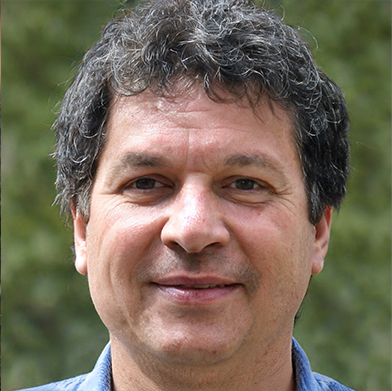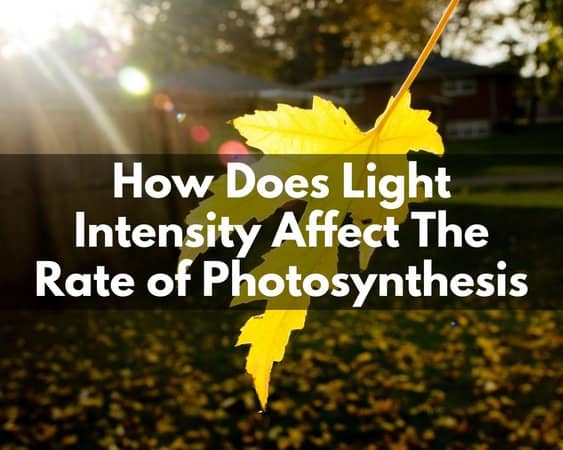This article answers the popular question, “how does light intensity affect the rate of photosynthesis?”
In plants, the conversion of light energy to chemical energy occurs during photosynthesis. The growth and production of plants are greatly dependent on this complex process.
This is how plants get the food they need to perform other special and critical functions to survive.
Ideally, the higher the rates of photosynthesis, the better the plant’s performance, especially when it comes to yields.
As you read along, you will have a comprehensive overview of photosynthesis.
We will look at the activities that take place during photosynthesis, the importance of this process to plants, and discuss the factors that affect the rate of photosynthesis.
What is Light Intensity?
Light intensity is also known as the level of light. Light intensity is basically the amount of energy hitting a particular area over some time.
In plants, light intensity is defined as the amount of energy or light hitting the leaves over a certain period.
What is Photosynthesis?
Photosynthesis is a vital process that contributes significantly to the growth/development of plants and other photosynthetic organisms.
This is when green plants and these organisms depend on sunlight to produce/synthesize nutrients that are essential to their growth and development from carbon dioxide and water.
With the aid of photosynthesis, plants produce their food. The food produced is vital not just only to the plant but also to other creatures that depend on them to survive.
When the rates of photosynthesis reach an optimum level, this supports maximum yields in plants.
In a shorter and more specific sentence, photosynthesis is a chemical reaction that stores sunlight and then turns it into sugar. The plant then uses this sugar as energy to perform several actions.
Before photosynthesis can occur in plants, chloroplasts are required.
Chloroplasts are specialized plant cells or cellular structures that capture light energy and then have it converted/transformed into chemical energy.
The first stage of photosynthesis involves capturing energy from sunlight, which is then used to break down or dissolve the water molecules. In the second stage, the generated energy is used to produce carbohydrates.
Ideally, 6 molecules of water and another 6 molecules of carbon dioxide (CO2) are used or expended to produce 1 molecule of glucose during photosynthesis.

Light Spectrum
The light spectrum is sometimes called the electromagnetic spectrum. This term discusses or identifies the range of all electromagnetic radiation frequencies. The sun emits the highest energy in the visible spectrum area, which is between 380 and 700nm.
The areas between 400-700nm are where photosynthesis occurs in plants. These regions/areas are usually called Photo-synthetically Active Radiation.
The light spectrum areas that drive photosynthesis are red (600-700nm), green (500-600nm), and blue (400-500nm) regions.
The highest activity takes place in the red area, followed by blue, and then green. In the green area of the spectrum, up to 75 percent of the light ends are used in photosynthesis.
The Limiting Factors of Photosynthesis Rate
In this section, we will discuss the major factors that may affect the rate of photosynthesis in plants. These are light intensity, carbon dioxide, and temperature.
At any point in time, any of these listed factors may end up being a limiting factor in the process.
Since these factors are significantly essential, they all have to be present and adequate for photosynthesis to occur. An absence or insufficiency in one of these factors jeopardizes the whole process.
a) Photosynthesis Rate Depending on Light
Irrespective of the availability or presence of other significant factors contributing to photosynthesis (adequate water & carbon dioxide and the right environment). When light is inadequate, this affects/restricts photosynthesis activity in plants.
During this time, plants suffer greatly due to their inability to produce sugar, a source of energy they need to perform vital actions.
As you increase the amount of light- moving from low light intensity to a higher intensity, this improves/enhances the rate of photosynthesis in plants due to the availability of a more considerable amount of light to support the reactions.
However, even when the light intensity is still high enough, the rate of photosynthesis may stop increasing due to certain limiting factors. For instance, when any other significant ingredients (carbon dioxide and water) are in short supply.
b) Photosynthesis Rate Depending on Carbon Dioxide
Carbon dioxide is another major reactant that contributes significantly to photosynthesis. An increase in carbon dioxide concentration brings about a rise or improvement in the rate of photosynthesis. This way, plants will be able to photosynthesize quickly.
Again, when one of the necessary reactants or factors that contribute to photosynthesis in plants becomes low in supply, this impacts the process.
During this time, irrespective of how high the amount of carbon dioxide is available, or attempts to further increase the concentration, it won’t have any effect on the rate of photosynthesis.
c) Photosynthesis Rate Depending on Temperature
The chemical reactions that involve the combination or mixture of water and carbon dioxide, leading to glucose production, are triggered by enzymes.
Just like every other enzyme-triggered reaction, temperature affects the rate of photosynthesis.
When the temperature becomes low, the number of molecular collisions between substrates and enzymes may limit the rate of photosynthesis.
When the temperature is high, the rate of photosynthesis also rises. However, the function and structure of the enzyme become altered when the temperature breaks the optimum range or becomes excessive.
How Does Light Intensity effect The Rate of Photosynthesis?
01. An Increase in Light Intensity May Limit The Availability of Another Vital Factor For Photosynthesis
In some cases, an increase in light intensity doesn’t automatically relate to more photosynthesis.
Just as we have discussed earlier in this article, other reactants or factors come into play regarding the rate of photosynthesis.
When any of these reactants is not enough, more light won’t count or matter. Water is an essential component in all stages of plant growth & development.
When there is insufficient/inadequate water for the plant, more light can be a huge problem. During this time, more water will evaporate or leave the plant through the holes in the leaves.
These holes are difficult to see with our bare eyes. You need to use a very strong/effective microscope to capture or see them.
Scarce water in plants, plus an increase in light intensity, illustrates how an increase in one factor can contribute to a sudden decline in another factor that is also critical for photosynthesis to occur.
02. A Low Light Intensity Limits The Rate of Photosynthesis & Affect Sugar Production
The most essential part of photosynthesis is sugar production from light energy. This sugar eventually forms a significant source of energy for plant activities.
When the light intensity is low, this affects the speed/level of photosynthesis. During this time, photosynthesis won’t take place, and there will be no production of sugar. In the end, the plants suffer greatly.
03. Higher Light Intensity May/ May Not Lead To an Increase in The Rate of Photosynthesis
If there is an increase or rise in the packets of light (photons) available to the plant, provided other contributing factors are sufficient, the rate of photosynthesis is significantly increased.
However, when the light intensity is excessive and photosynthesis is restricted due to a shortage of water and/or carbon dioxide, this may start causing damage to plants. This is when plants begin to experience a sunburn, creating visible large brown areas on the leaves of the affected plants.
People Also Ask For
How Important is Light Intensity in Photosynthesis?
Usually, water, temperature, light, carbon dioxide, and even Chlorophyll must be available and adequate for photosynthesis to occur. However, light is a very vital factor in this process.
Suppose all other major factors are available and sufficient. In that case, light becomes the remaining factor needed to complete the puzzle. When the light intensity is also adequate, this brings about the maximum rate of photosynthesis.
When it comes to photosynthesis, the energy derived from the sunlight is eventually used to convert carbon dioxide (CO2) and water to produce sugar.
What Are the Limiting Factors in Photosynthesis?
These are factors that affect or limit the rate of photosynthesis in plants when they become inadequate or short in supply. These factors are light intensity, carbon dioxide, and temperature.
What Does Chlorophyll Do in Plants?
Chlorophyll does absorb the adequate amount of light required to initiate a conversion between carbon dioxide & water to give/form glucose. Leaves that have a high amount of Chlorophyll have excellent light absorption traits.
Hence, they find it easier to absorb the required light for photosynthesis, provided other factors are sufficient/stable. https://www.youtube.com/watch?v=1curtzL8rUM
How does the amount of Chlorophyll affect photosynthesis?
Although the major factors that affect the rate of photosynthesis are light intensity, carbon dioxide, and temperature, Chlorophyll also has its influence to some certain extent.
In some specific environments where the lighting conditions are not adequate or favorable for photosynthesis to occur, plants in these environments synthesize an extra amount of Chlorophyll to get as much light as is needed.
Also, some diseases may affect the amount of Chlorophyll in plants, thereby restricting/limiting their ability to photosynthesize. For instance, in grapes, the condition known as downy mildew affects the amount of Chlorophyll present in the affected plant.
What is the compensation point?
The compensation point is known as the light intensity at which there is an equivalence between the rate of photosynthesis and respiration rate. (Rate of photosynthesis = the respiration rate).
How is the rate of photosynthesis measured in the laboratory?
There are several methods or techniques used in the laboratory to know or figure out the rate of photosynthesis. These techniques are the level of glucose production, also known as carbohydrate, the amount of oxygen output, and the amount of carbon dioxide uptake.
However, these techniques are not perfect since plants will as well be respiring. This way, a certain amount of oxygen and carbohydrate are expended. Also, the carbon dioxide output is increased.
How Do Plants Get The Adequate Amount of light needed/required for photosynthesis?
Photosynthesis needs a sufficient amount of light intensity, just as it needs the other reactants in the appropriate mix/proportion.
Since environments are different in elements and composition, plants are naturally equipped with relevant support mechanism that enables them to survive and compete in their respective habitats.
This is why plants in various environments are built differently or have distinct structures to help them access an adequate/sufficient amount of light.
For instance, plants in the rain forest, an environment with a sufficient amount of water. Plants, especially trees in this area, grow very tall, ensuring they have access to as much light as they need.
In deserts, where there is little/no access to water, plants in this area have access to sufficient light.
At the same time, they control or reduce excess light that could increase the temperature in the environment, leading to sunburn or causing the plants to dry out.
Plants in the desert grow/develop hairs and scales on their respective leaves. These parts of the leaves are used to regulate the intensity/level of light that the plants get.
Why Do Leaves Experience a Change in Color in Autumn?
You may experience a change in plant leaves from green to brown, yellow, red, or orange in autumn due to an adjustment in the photosynthesis process.
Asides from Chlorophyll, plants have other varieties of pigments. As winter approaches, irrespective of the environments/climates, there is always a drop in the amount of Chlorophyll they produce.
As a result, there won’t be sufficient Chlorophyll to showcase the green light, which enhances the visibility of other pigments.
Final Words
We hope this article has answered the question, “how does light intensity affect the rate of photosynthesis, and has provided you with enough clarity to satisfy/feed your curiosity.
However, photosynthesis is a broad study/topic, especially when you consider the numerous interactions between plants & light or plants and other vital factors that are important for photosynthesis to take place.
Although some of these interactions that occur during this process are complicated, the more you continue to investigate or find out more about the relationships between all the factors involved, the more fun and interesting it becomes.

Hello! My name is John Smith. I’m the creator of this website. Since childhood, I had a passion for cars and its mechanisms. So, I started working in the automotive industry when I just left school, and how I have over 10 years of experience in this industry. To make my experience alive through the content I started blogging through Lighting Sparkle. I hope that my experience through the content can help you a lot in making decisions and learning.

